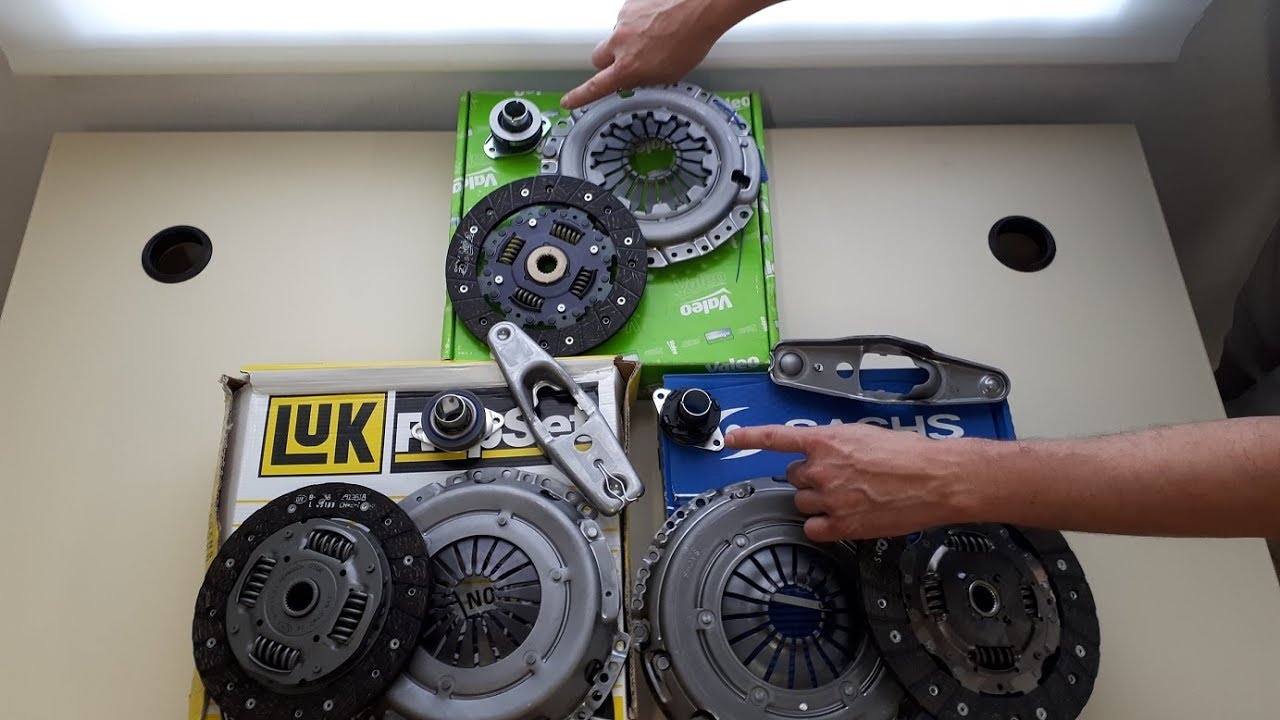
Skoda Fabia clutch replacement
Content
This winter it has become difficult to climb the mountains at high speed, especially with people behind. The clutch box was especially felt at 3 and 4 speeds. Gear shifting was fine as the release was normal. But according to the technical regulations, the replacement is carried out in chorus: basket + disk + disengagement. I bought the same one that was from the factory SACHS 3000 951 051
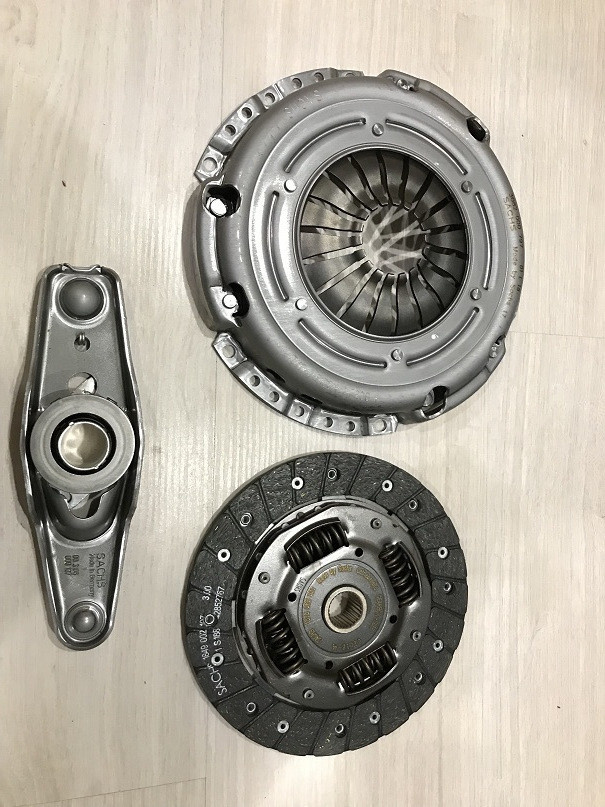
I was too lazy, I thought to give it to the service, I called SamaraAvtoBohemia, they announced the price of 10600 rubles! Carl, this is without parts! I myself decided.
I also studied the manual, what and how, prepared and bought a head for 14 and a plug for a basket, and a hexagon for 7. All this could then be pushed into someone, more on that later. When replacing the clutch, you will need to remove the inner grenades from the flanges so that there are tension bolts, so I bought 12 new N91108201 bolts. The keys are the main workers for 16 and 18, asterisks for asterisks for 9 and 8.
To remove the crankcase, DO NOT remove: clutch slave cylinder, cross member (subframe), radiator, thermostat. And it is MANDATORY to remove: gear flanges (oil does not drain), cable connection, battery rack, starter, gear lever and gearbox bracket from above! and below!
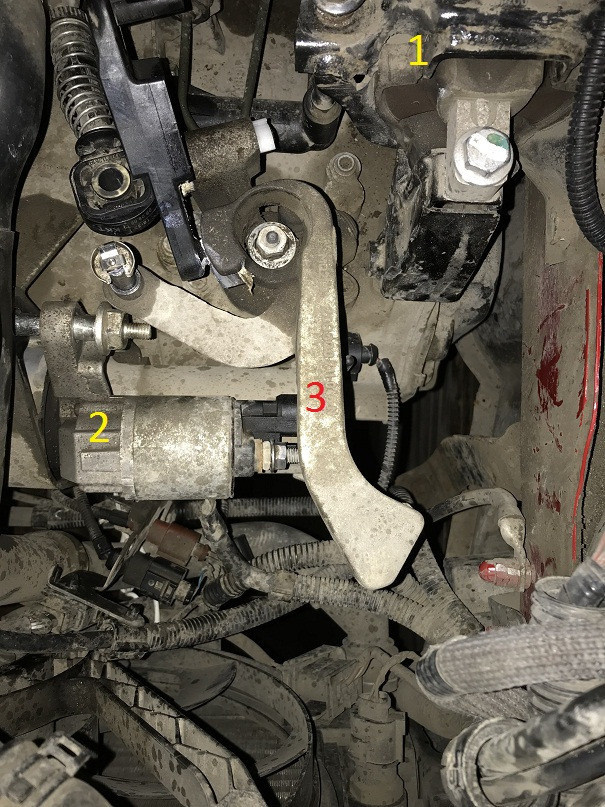
Many people know that to install a disk in a basket, you need a VAG mandrel, it costs from 750 to 1450 rubles. or remembering that 80% of the input shafts of a small car are the same, they bought a mandrel for a VAZ 2107 for 100 rubles:
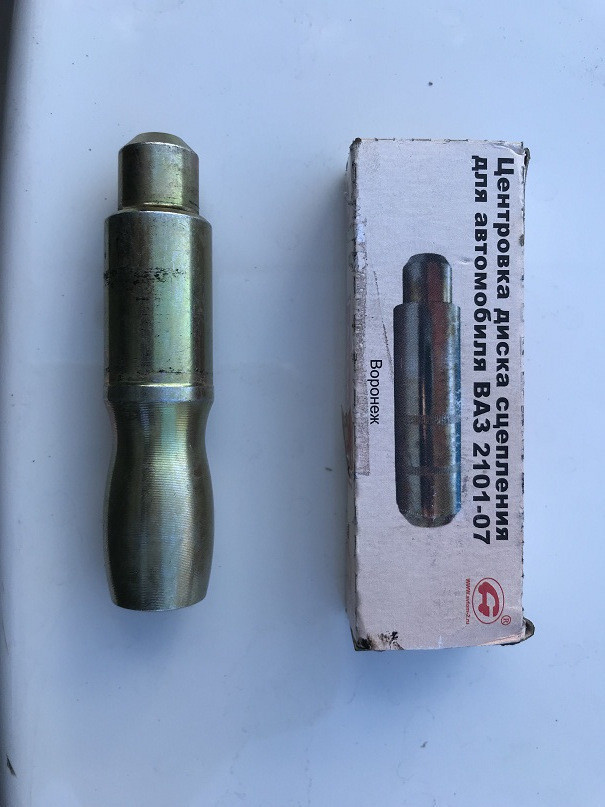

I found a bonus (you can check it yourself) by removing the chips from the starter from above, in the retractor relay, a wire break. A thick bundle was placed very incorrectly, from which a thin wire comes out, because of which it frayed the corrugation and insulation.


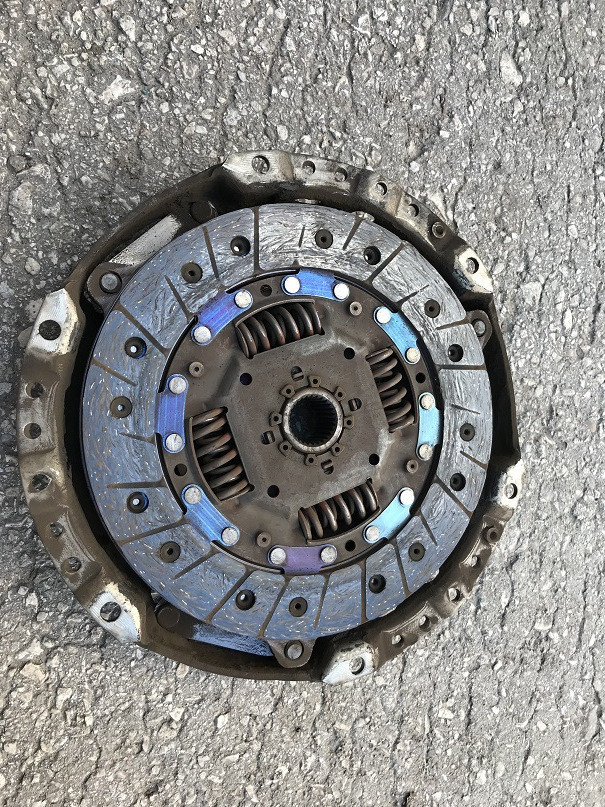

I am often asked, if you change the old clutch, do you need to change the flywheel just in case? NO NO, it occurred to the automotive industry that the Ferodo rivets of the lining discs are facing the basket, the driven disk has marks in front and behind, therefore, with maximum wear, the basket suffers first (this is a consumable type), and the flywheel fits normally after 3- x clutch replacements, unless of course you have APR2 and REVO.
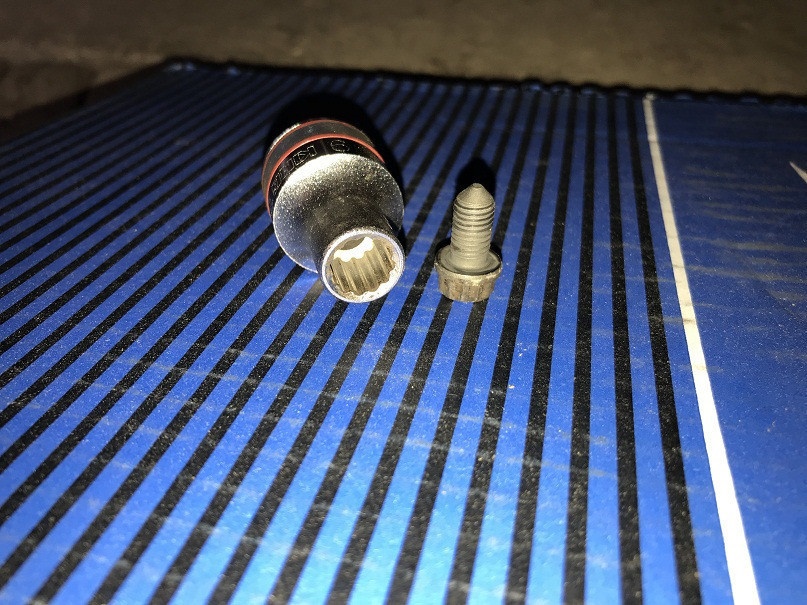
These are bolts to hold the basket (they are not in the manual), I had to urgently buy a crown for 9. There is also no hexagon for 7 on the pitch, it is held by an “asterisk” for 8.
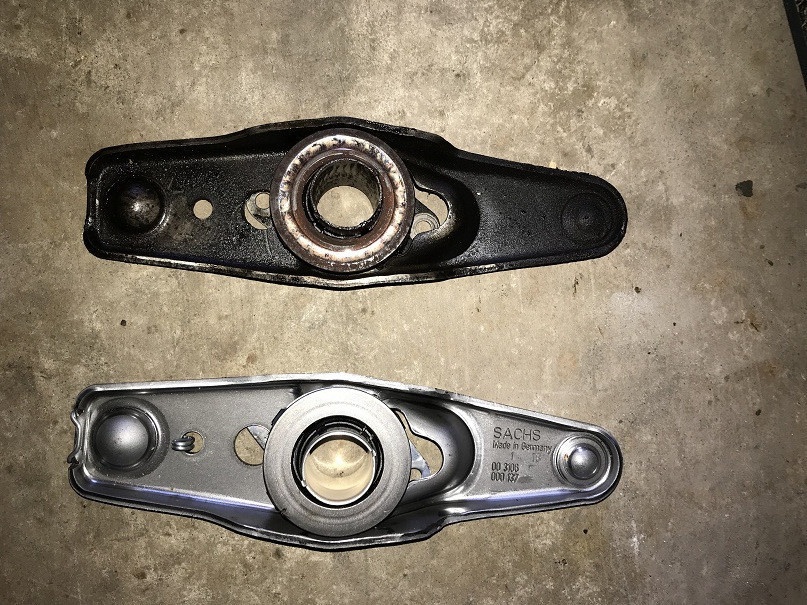

We collect everything back. We put the internal grenades without losing the internal rubber gaskets. And we take out new screws with a torque of 20nm and a turn of 90 degrees so that they do not get out like some))))

After the replacement, the clutch began to stick at the bottom (in the "beginning" in the sense).
Good luck to everyone and do not drift in mountain towns!

I won’t say that the need to replace the clutch fell out of the blue, for many it happens unexpectedly: yesterday the clutch was still working, but today it’s not anymore ... In my case, the “X” hour approached gradually, quite predictably, especially since the mileage smoothly approached 197000 km and the clutch, apparently, is still native, from the factory.
The first disturbing calls began last winter: in frosts, when warming up, characteristic hissing sounds appeared from under the hood from the gearbox side, changing the pitch of the sound or disappearing when the clutch pedal was pressed. As it warmed up, the sounds disappeared.
Then there was a period of a month when these sounds completely disappeared for some time, they were replaced by a slight trembling in the clutch pedal at the moment of touching the foot or very light pressure. A little later, there was a feeling that the force on the pedal was not constant when it was tightened: at the end of the amplitude, it was necessary to press a little more, before this was not the case. At the same time, the gears were still switched on easily, there was no obvious drop in traction, although the clutch was switched on last, i.e. The car started only when the clutch pedal was fully depressed. And just a week before the scheduled repair date.
From the very beginning it was clear that the problem was at least with the release bearing and this problem needed to be solved, so I am very grateful to the machine for letting me wait for spring and for the time when personal work allowed me to deal with this. Problems.
Actually, there were initially two questions: which clutch to choose and where to change it.
In the first question, the choice was not successful: among the well-known manufacturers there are LUK, SACHS, VALEO. At first I didn’t consider other manufacturers, if SACHS has a clutch for a 1,2l engine, then it comes in a kit consisting of a disc, a basket and a release bearing, the other two kits were not offered for my engine as such.
It was possible to collect all 3 components separately in one set, but in the end it would have come out at least 30% more expensive. Initially, I wanted to lean towards VALEO components - I read flattering reviews about the clutches of this company, but the price and waiting times returned to reality, which was extremely simple - they don’t look for good from good, so I settled on SACHS: proven quality, good reviews, more than adequate the price for a ready-made kit, and in the original only such a clutch: what else is needed for the right choice ...
Also, just in case, I ordered a pressure ball pin for the clutch fork - it is metal, but its ball head is filled with plastic - I was afraid that for almost 200 km the plastic on the old finger might be worn out, and this could lead to a squeal when the clutch is depressed.
Just ordered a rear crankshaft oil seal; I did it in case a visual inspection after removing the gearbox revealed its tendency to an early leak; Naturally, in this case it would be advisable to replace it.
Parts arrived and took away.
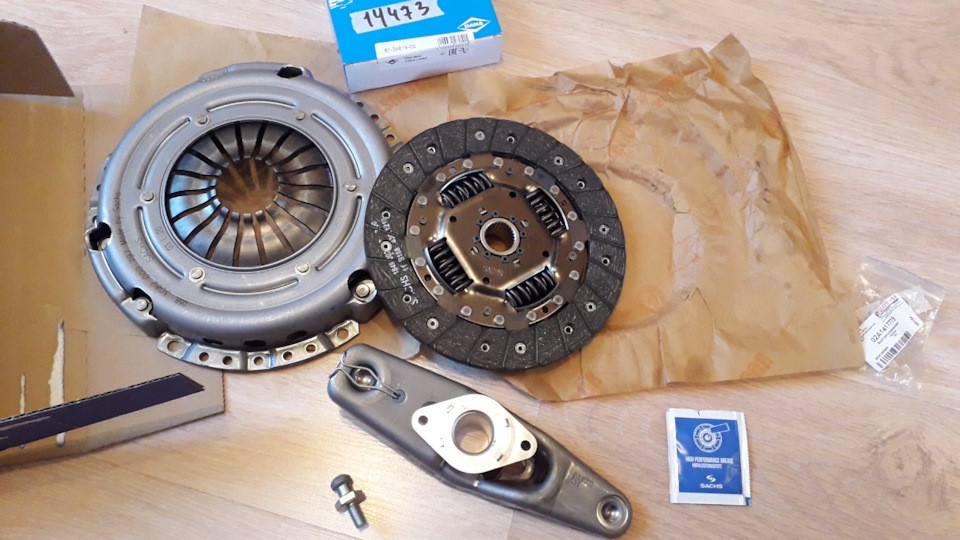
Clutch kit SACHS 3 000 951 051 - 6200 rubles
Crankshaft rear oil seal VICTOR REINZ 81-34819-00 — 1100 rubles
Ball pin 02A141777B - 500 rubles

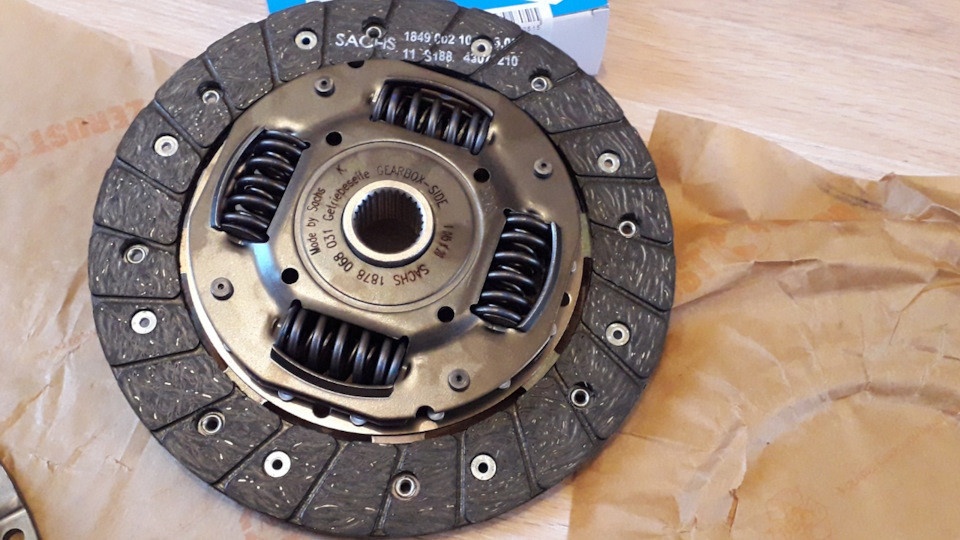
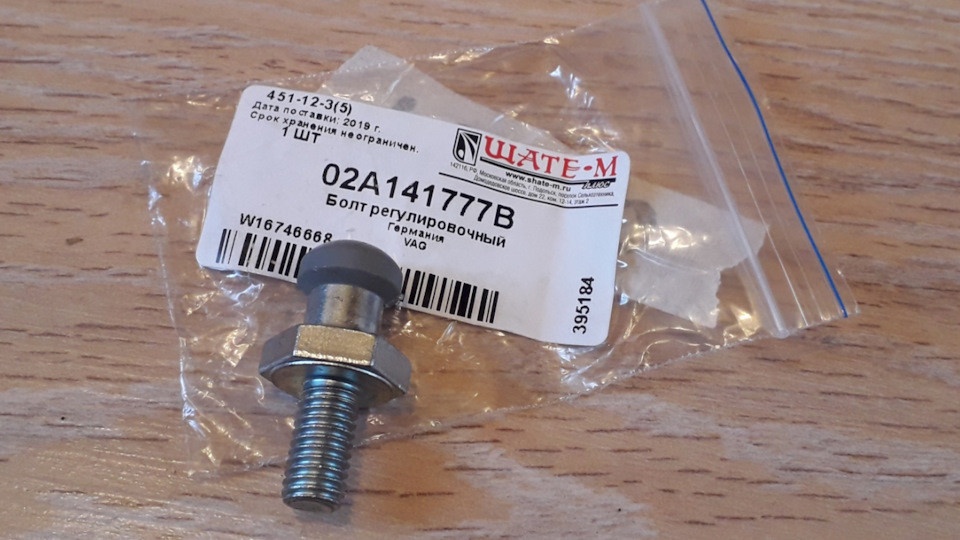
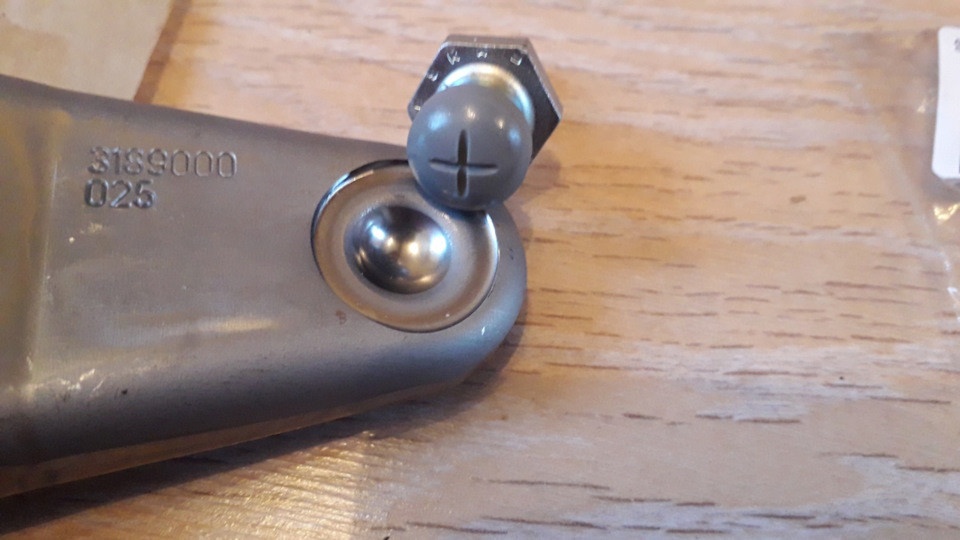
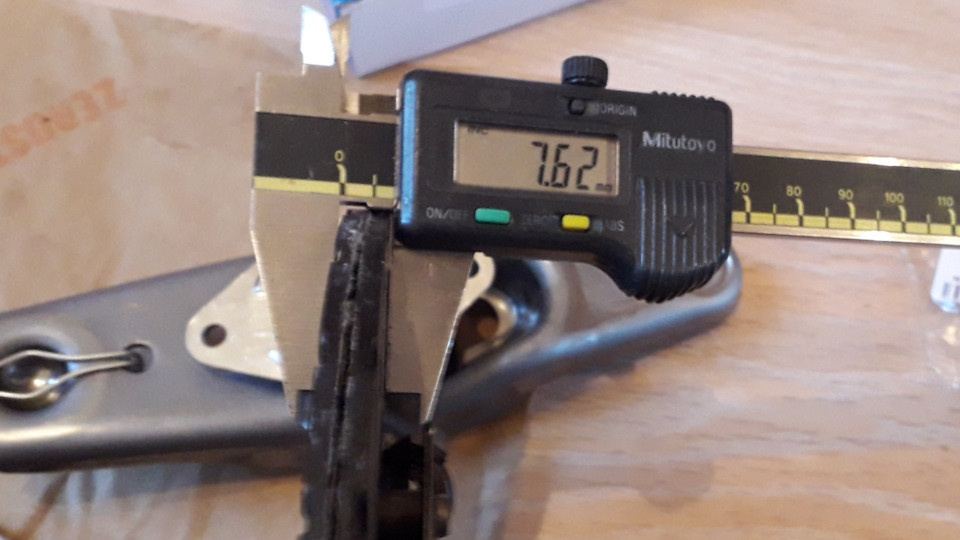
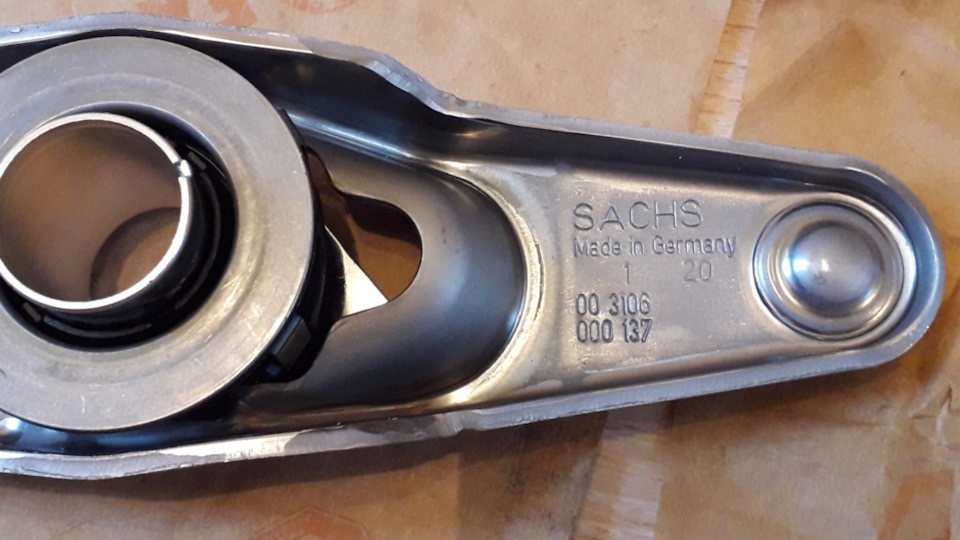
While the ordered spare parts were being transported, the second question was solved: how and where to change the clutch.
There were thoughts of doing the work on our own, but for various reasons this idea had to be abandoned. At first glance, there are no particular difficulties in the process, I think it is no more difficult than replacing the timing chain, which I did earlier on my own. On the other hand, I wanted to play with it myself, with my own hands, but at least a pit is needed, although if you wish, you can start this process with bricks, but these are too harsh conditions. After weighing all the pros and cons, as well as the need to rent a pit, or rather a lift, at least for six to seven hours, find and buy at least one mandrel for the clutch basket, the need to involve someone to shoot together - put a checkpoint , because solo, it's almost impossible.
After analyzing the offers of various resources, I singled out the average cost of such a service, which is 4 rubles for private garage masters and up to 000 rubles for mid-level car services.
One thing was embarrassing - I perfectly understood that no one was safe from the jambs and crooked hands of the masters, and no one would wash and clean the removed parts; at best, they will shake off the lumpy dirt, which is why I repair the car myself, because such moments are very important to me.
In most services, they are not happy with the legitimate desire of the client to be present during the repair, and at this time an additional iron argument has been “concocted”: a pandemic, distance, isolation and everything connected with this.
But he still managed to find the right guys within a 5km radius of his house: a private three-lift service.
In 6,5 hours, the clutch was replaced in my presence, everything that needed to be cleaned, washed, blown, lubricated. And all this for 5500 quite human rubles.
Even at the stage of collecting information, I found a very useful report by a respected author, for which, of course, thanks to him with only one amendment from me - the report contains a clear recommendation DO NOT REMOVE the subframe, although based on the results of the work done, I can say that it is much easier if it (subframe ) is still removed - this is not at all difficult, but it greatly facilitates maneuvering with the box to ease the hand in a narrow space at the time of its removal and subsequent placement in its rightful place. The fact is that I initially refused the mechanic's offer to disassemble the subframe; as an argument, I showed him a previous report, which clearly stated: do not remove the subframe! The mechanic sighed.
That is why, when it came to removing the fully unscrewed gearbox, the dance of the tambourine began: all three had to remove the box, because two were holding it, and the third tried to maneuver in a narrow space, trying not to crush the radiator and numerous wires around it with protruding from the control point CV joint flange. Looking ahead, I will say that the repositioning of the checkpoint was even more “interesting”.
As a result of the work performed:
The release bearing fell apart and finally jammed, its plastic cage burned along with the fork - I drove to the service almost “on one wing”. The basket, of course, is also worn out, but not so critical, which cannot be said about the clutch disc, it has worn down to the rivets. At the same time, the car drove quite quickly and switched well (except for reverse gear).
Replacing the clutch
When repairing a checkpoint, this service is provided FREE OF CHARGE.
Replacing the Skoda Fabia clutch is not an easy process.
The fact that the Skoda Fabia clutch will soon have to be repaired or completely replaced can be signaled even by the pedal itself, which is responsible for this. Many car owners note that the Skoda Fabia can only "take" the clutch at the top, and with strong acceleration in 4th and / or 5th gear, the speed increases without increasing the car's power. In advanced cases, you can hear a rather "eloquent" rattle of metal on metal or even a howl. Experts strongly do not recommend bringing this node to such a state, because it is very unreliable. If we talk about how and to whom to replace the Skoda Fabia clutch, then in this matter you should definitely rely on the skill and experience of car mechanics.
Of course, today on the Internet you can find reviews-reports of car owners who repaired the Skoda Fabia clutch on their own. And if you carefully read these "instructions", you can see how many problems the car owner had to face. This is the lack of equipment, the necessary tools and ignorance of the sequence of disassembly / disassembly of the assembly, and the lack of necessary spare parts (often completely different parts and assemblies are bought, which then simply gather dust for spare parts). Garage shelves or are desperately sold on the same forums).
Replacing the Skoda Fabia clutch is, in fact, one of the most complex processes that requires the mechanic to have certain skills and relevant knowledge of all the nuances, as well as the availability of the necessary equipment / tools (for example, crankshaft clamps and centering mandrels). Skoda Fabia clutch repair usually does not take much time if it is carried out by a professional. And therefore, if you really value your time, your own strength and money, entrust this process to specialists.
Replacing the Skoda Fabia clutch is the main specialization of our auto technical service, so we carry out this type of repair work not only quickly and efficiently, but also with a long-term guarantee for the repair / replacement. Clutch repair Skoda Fabia is associated with many features. Absolutely everything is really important here, even the magnitude of the bolt torque, which, again, can only be determined by specialists with special equipment.
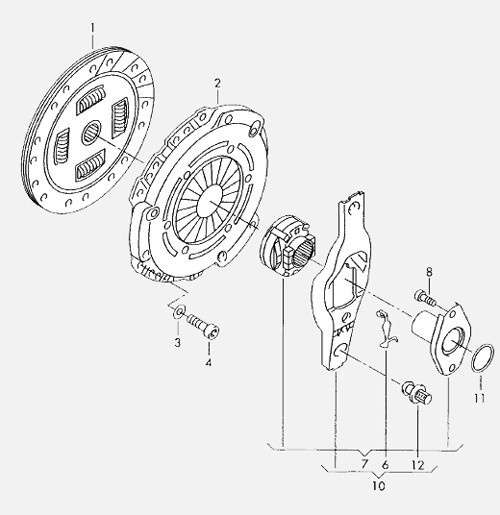
1 clutch disc
047141034J 190mm for ARV, AQV engines
047141034JX 190 mm for ARV, AQV engines
047141034K 190mm for AME, AQW, ATZ, AZE, AZF engines
047141034KX 190mm for AME, AQW, ATZ, AZE, AZF engines
2 Clutch basket (clutch pressure plate)
Shkoda Fabia DSG clutch replacement - 5900 rub.
Each client of the Moscow technical center has access to services for replacing the clutch DSG 7 Skoda Fabia.
Going to the mechanic, you have the opportunity to undergo a full diagnosis on modern equipment and inexpensively restore a used car.
It is worth planning a trip to specialists in the near future if the collapse has made itself felt.
Problems are indicated by signs such as the presence of the smell of burnt linings in the cabin, failure of the clutch pedal when you press it, the appearance of extraneous sounds, vibrations when starting off and when shifting gears.
Don't put off repairs.
Turning to professionals immediately after discovering a transmission failure is the only way to save on car restoration.
What are the benefits of using the service
A trip to a specialized service gives the car owner the following benefits:
- 100% accurate diagnostics on equipment recommended by the dealer;
- assistance in the selection of spare parts necessary for repair work;
- purchase of components at purchase prices;
- installation of turnkey parts immediately after purchase;
- warranty up to 2 years.
There are frequent situations when the failure of some transmission units completely immobilizes the car.
In this case, it will be possible to deliver the car to the territory of the workshop on a tow truck.
This service, as well as diagnostics within half an hour from the moment of arrival at the service station, will have a free cost if you make an appointment for repairs.
What does the car owner get?
Contacting a specialized service center with more than 10 years of history in the DSG robotic gearbox service market gives the car owner access to the following opportunities:
- purchase of spare parts at the best prices in the city;
- minimal time spent on restoring a foreign car;
- free consultations on any problem related to repair work;
- selection of spare parts by professional craftsmen;
- long warranty.
After replacing faulty components, mechanics check the performance of the repaired unit as a whole.
Compliance with current regulations is a guarantee that in the future you will no longer have to turn to specialists.
How to get to the workshop
You can choose a suitable date and time for visiting a car service, you can make an appointment with a specialist through a specially provided feedback form on the website or by phone.
After that, all that remains is to replace the Skoda Fabia DSG clutch at the appointed time in order to hand over the car to a team of experienced craftsmen.
Skoda Fabia clutch replacement

The clutch system is the connecting element between the engine that transmits torque and the gearbox that distributes it. The nature of malfunctions manifests itself in different ways depending on the specifics of driving, the style of operation of the car, and the timeliness of maintenance. Structurally, the clutch includes a friction disc, a basket and a release bearing. All parts are interconnected by a number of additional elements. Replacement work should be entrusted to service center employees.
skoda fabia clutch replacement calculator
Typical faults
Regardless of the style of vehicle operation, owners are advised to perform a complete system replacement. With selective installation of components as they wear out, the owner will have to regularly spend time and money on maintenance. Installing a set of new parts will free a person from such a need.
As a result of long-term practical work with the model in question, it was found that in most cases the replacement of the Skoda Fabia clutch is necessary for the following reasons.
- Friction disc failure.
- Spontaneous departure of friction springs from the seats.
- Failure of the cylinder due to its depressurization, the cause of which is the wear of the sealing elements.
- Stuck release bearing.
- Broken clutch cable.
In order to avoid serious damage, it is recommended to check the condition of the clutch in a timely manner. The optimal service life is 70-80 thousand kilometers, depending on the dynamics and operating conditions of the car as a whole.
Replacement Features
The procedure for installing a new kit is more complicated, as the craftsmen have to completely disassemble the gearbox. Therefore, it is not recommended to work in the garage. And the result obtained by the owner does not guarantee complete safety of operation.
The master determines the condition of the clutch through diagnostics using computer equipment. Next, the gearbox is removed, the complete removal of all worn out elements and the installation of new ones. After adapting the electronic control unit, you can continue to use the car.
You can order this service from DDCAR, where clutch replacement is one of the main areas.
Clutch Skoda Fabia / Fabia Combi from 2007
Clutch
Clutch control actuator
Clutch pedal assembly
- Frame / partition separating the engine compartment from the passenger compartment
- Seal
- Bearing housing (support bracket)
- Screw
- Accelerator/Brake Pedal Mechanism
- Nut (28 Nm)
- Clutch pedal switch
- Return spring
- Carrier
- bearing journal
- Clutch pedal
- Fixation
- Nut (28 Nm)
- Clutch Master Cylinder
- Spring clamp
- Additional hose
- Support (bearing)
- Screw
- Stop pedal
- Nut (28 Nm)
clutch switch
Withdrawal
- Remove the bottom cover from the driver's side.
- Disconnect the clutch pedal switch connector (1.
- Turn the clutch pedal switch (2) on the pedal bracket 45° counterclockwise, remove it from the bracket.
Note:
The clutch pedal remains in neutral (not depressed).
Installation
- Before proceeding with the installation of the clutch pedal switch, the pin (3) must be completely removed. Clutch pedal (4) is in neutral position.
- Install the clutch pedal switch through the mounting hole, secure it while pressing it against the clutch pedal, and rotate it 45° clockwise.
- Connect the clutch pedal switch connector.
- Install the bottom cover on the driver's side.
Return spring
Withdrawal
- Remove the bottom cover from the driver's side.
- Remove the protective bracket (if installed).
- Remove the clutch pedal sensor, if installed.
- Disconnect the clutch master cylinder rod from the clutch pedal:
- install pliers (T10005) in the grooves of the clutch pedal;
- press the bracket, disconnect the master cylinder clutch pedal from the clutch actuator control amplifier.
Press the return spring against the waterproof housing in the direction of the arrow, remove it from the bracket from below.
Installation
- Install the bracket (bracket) of the return spring (arrow 1) on the support bracket. The protrusion of the bracket is located in the recess of the clutch booster master cylinder (arrow 2).
- The tide of the bracket is located in the hole of the master cylinder of the clutch booster (arrow 2).
- Press the return spring against the bracket, install it on the clutch pedal bracket (arrow).
- Connect the clutch pedal to the brake master cylinder.
- Install the clutch pedal switch.
- Install the protective bracket.
- Install the bottom cover on the driver's side.
hydraulic drive
- brake fluid reservoir
- Шланг
- Clutch Master Cylinder
- Safety clamp
- Fixation
- Clutch pedal
- Nut (28 Nm)
- Sealing ring
- tube with hose
- Holder
- Holder
- Bolt (20 Nm)
- Safety clamp
- dust cap
- Air valve
- Clutch release slave cylinder
- Transmission
Checking the hydraulic clutch control
Note:
If the slave cylinder of the clutch release actuator with the tube attached to it is removed from the gearbox, do not press the clutch pedal. Otherwise, the piston may come out of the slave cylinder of the clutch release actuator and become unusable.
The clutch hydraulic system is connected by an additional hose (arrow 1) to one of the chambers (arrow 2) of the brake fluid reservoir.
If there is little or no brake fluid in this chamber, the system may be leaking.
External leaks are manifested by traces of brake fluid in or under the gearbox, as well as in the lower engine crankcase under the gearbox.
Check the correct installation of the pipe and pipe connection between the clutch booster master cylinder and the clutch slave cylinder. Cables cannot be bent at sharp angles or pinched in any way.
Pedal return cannot be prevented by displaced or additional car floor coverings (carpet).
Read more: VAZ 1118, 1119 Lada Kalina
1. Inspect the following hydraulic clutch control parts for leaks:
- check the brake fluid level in the hydraulic brake reservoir;
- an additional hose between the reservoir of the hydraulic drive of the brakes and the main cylinder of the clutch control amplifier;
- clutch booster master cylinder;
- a branch pipe between the main cylinder of the clutch control amplifier and the clutch slave cylinder;
- joints (threaded connections), where they are not visible;
- release the slave cylinder.
2. Remove the clutch release cylinder (without opening the wiring system), check the bellows for brake fluid leaks by removing the bellows from the stem (arrow).
3. If necessary, remove air from the clutch system.
4. Next, you should carefully depress the clutch pedal, holding the pedal at full speed in five different positions for about 20 seconds, and at the same time check if the pedal does not fall by itself at the time of maintenance (within five posts). At the same time, a second mechanic checks to see if fluid is getting to the rest of the hydraulic clutch control components.
Bleeding the clutch control system
- Remove the engine top cover.
- With the ignition off, disconnect the wire connecting the battery terminal to the vehicle ground (body.
- Remove the air filter.
- Remove the battery and battery holder.
- Connect the device for filling the brake hydraulic drive and removing air from it.
- Connect the bleed hose (A) to the bleed valve of the clutch slave cylinder (arrow), open the valve.
- Fill the system with brake fluid at a pressure of 0,2 MPa.
- Allow approximately 100 cm3 of brake fluid to flow out until no more air bubbles appear.
- Close the air release valve.
- Press the clutch pedal 10. 15 times from lock to lock.
- Open the air valve.
- Fill the system with brake fluid at a pressure of 0,2 MPa.
- Drain another 50 cm3 of brake fluid.
- Close the air release valve.
- After completing the bleeding process, depress the clutch pedal several times.
Clutch control master cylinder
Removal and installation
1. With the ignition off, disconnect the wire connecting the battery terminal to the vehicle ground (body
2. Remove the engine top cover.
3. Remove the air filter.
4. Remove the battery and battery holder.
5. Close the inlet hose of the clutch booster cylinder (A) with a clamp (MP7-602 (3094)) (if the hose is plastic, do not use the clamp (MP7-602), otherwise plastic additional hose).
6. Disconnect the hose (A) from the hydraulic brake reservoir, close it properly.
7. Remove the safety clip (B) from the clutch booster master cylinder.
8. Remove the clutch master cylinder tube (C), close.
9. Remove the bottom cover from the driver's side.
10. Remove the clutch pedal safety bracket (if installed).
11. Remove the clutch pedal switch (if equipped).
Note:
To remove the clutch master cylinder, completely remove the clutch pedal mechanism. However, before proceeding with the removal, it is necessary to disconnect the clutch booster master cylinder from the clutch pedal.
12. Disconnect the clutch master cylinder rod from the clutch pedal. The clutch booster master cylinder control rod is disconnected from the clutch pedal as follows:
- install pliers (T10005) in the grooves of the clutch pedal;
- press the bracket, disconnect the master cylinder clutch pedal from the transmission clutch control amplifier;
- remove return spring.
13. Having unscrewed the nuts (arrows 1), remove the clutch pedal assembly (arrow A) with the master cylinder of the clutch control amplifier.
14. Disconnect the pedal stopper.
15. Remove the clutch booster master cylinder.
16. Installation is carried out upside-down.
Note:
The bracket (A) must be on the clutch master cylinder control rod (B.
For the correct entry of the bracket into a fixed position, it is necessary to press the clutch pedal against the front wall of the body, which separates the engine compartment from the passenger compartment in the direction of the arrow; at the same time it is necessary to monitor the correct lock
After installing the clutch booster master cylinder, bleed the clutch system.
Clutch release slave cylinder
Removal and installation
1. With the ignition off, disconnect the wire connecting the battery terminal to the vehicle ground (body.
2. Remove the engine top cover.
3. Remove the air filter.
4. Remove the battery and battery holder.
5. Remove the circlip (arrow 1) from the shift cable from the shift lever (A).
6. Remove the metal selector lever (cars manufactured before 05.07). For this:
- remove the circlip (arrow 2) of the selective shift cable from the selector lever guide (B);
- remove the electric drive of the device for selective control of gear shifting and the electric drive of gear shifting from the pins;
- Remove the circlip arrow (3) from the selector lever guide (B), remove the selector lever guide.
7. Remove the plastic selector lever (vehicles from 06.07). For this:
- remove the Bowden cable drive of the trunnion gearshift;
- remove the selector lever guide along with the flexible shaft retainer (Bowden cable).
8. Remove the shift lever (A), for which it is necessary to unscrew the nut (arrow 4).
9. Remove the flexible roller bearing (Bowden cables) from the gearbox (arrows).
10. Attach the shift cable and preselective shift cable to the top.
11. Place a rag under the clutch release cylinder.
Note:
Make sure that no brake fluid enters the transmission. If this happens, then you need to thoroughly clean this place.
12. Close the clutch master cylinder tube with clamp (MP7-602 (3094)) (if the clutch master cylinder tube is plastic, do not use clamp (MP7-602 (3094)) 602).
13. Remove clamp (A) from clutch slave cylinder tube until it stops.
14. Pull tube out of bracket (C).
15. Remove the pipe (B) from the slave cylinder of the clutch release actuator, close the hole.
16. Disconnect the clutch release cylinder (arrows), remove.
Note:
Do not press the clutch pedal.
17. Installation is carried out upside-down.
